client-go连接kubernetes集群-create
Posted saynaihe
tags:
篇首语:本文由小常识网(cha138.com)小编为大家整理,主要介绍了client-go连接kubernetes集群-create相关的知识,希望对你有一定的参考价值。
背景
client-go连接kubernetes集群-connect and list。都是查看获取list列表的。现在想用client-go创建应用该如何操作呢?
client-go连接kubernetes集群-create
创建一个namespace:
clientset.CoreV1().Namespaces().Create
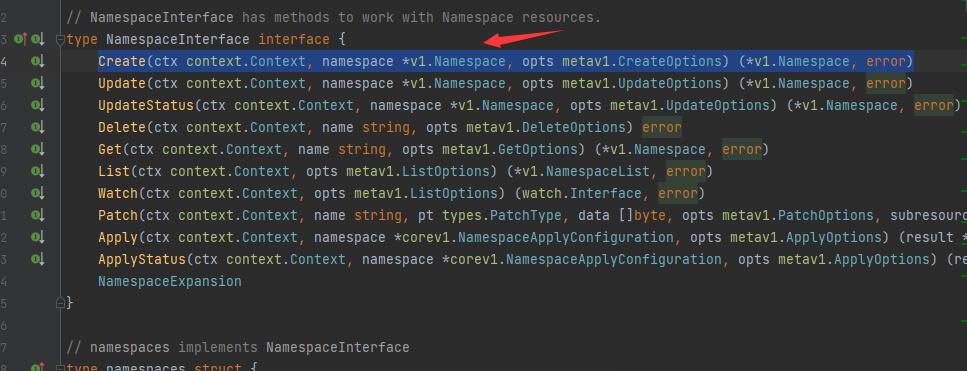
package main
import (
"context"
"flag"
"fmt"
v1 "k8s.io/api/core/v1"
metav1 "k8s.io/apimachinery/pkg/apis/meta/v1"
"k8s.io/client-go/kubernetes"
"k8s.io/client-go/tools/clientcmd"
"k8s.io/client-go/util/homedir"
"path/filepath"
)
func main()
var kubeconfig *string
if home := homedir.HomeDir(); home != ""
kubeconfig = flag.String("kubeconfig", filepath.Join(home, ".kube", "config"), "(optional) absolute path to the kubeconfig file")
else
kubeconfig = flag.String("kubeconfig", "", "absolute path to the kubeconfig file")
flag.Parse()
config, err := clientcmd.BuildConfigFromFlags("", *kubeconfig)
if err != nil
panic(err.Error())
// create the clientset
clientset, err := kubernetes.NewForConfig(config)
if err != nil
panic(err.Error())
namespace := &v1.Namespace
ObjectMeta: metav1.ObjectMeta
Name: "zhangpeng",
,
result, err := clientset.CoreV1().Namespaces().Create(context.TODO(), namespace, metav1.CreateOptions)
if err != nil
fmt.Println(err)
else
fmt.Printf("Create ns %s SuccessFul !", result.ObjectMeta.Name)
list, _ := clientset.CoreV1().Namespaces().List(context.Background(), metav1.ListOptions)
for _, item := range list.Items
fmt.Println(item.Name)
//fmt.Println(clientset.ServerVersion())
//list, _ := clientset.CoreV1().Namespaces().List(context.Background(), metav1.ListOptions)
//for _, item := range list.Items
// fmt.Println(item.Name)
//
//
//fmt.Println("pod list in develop")
//list1, _ := clientset.CoreV1().Pods("develop").List(context.Background(), metav1.ListOptions)
//for _, item := range list1.Items
// fmt.Println(item.Name)
//
//
clientset.AppsV1()
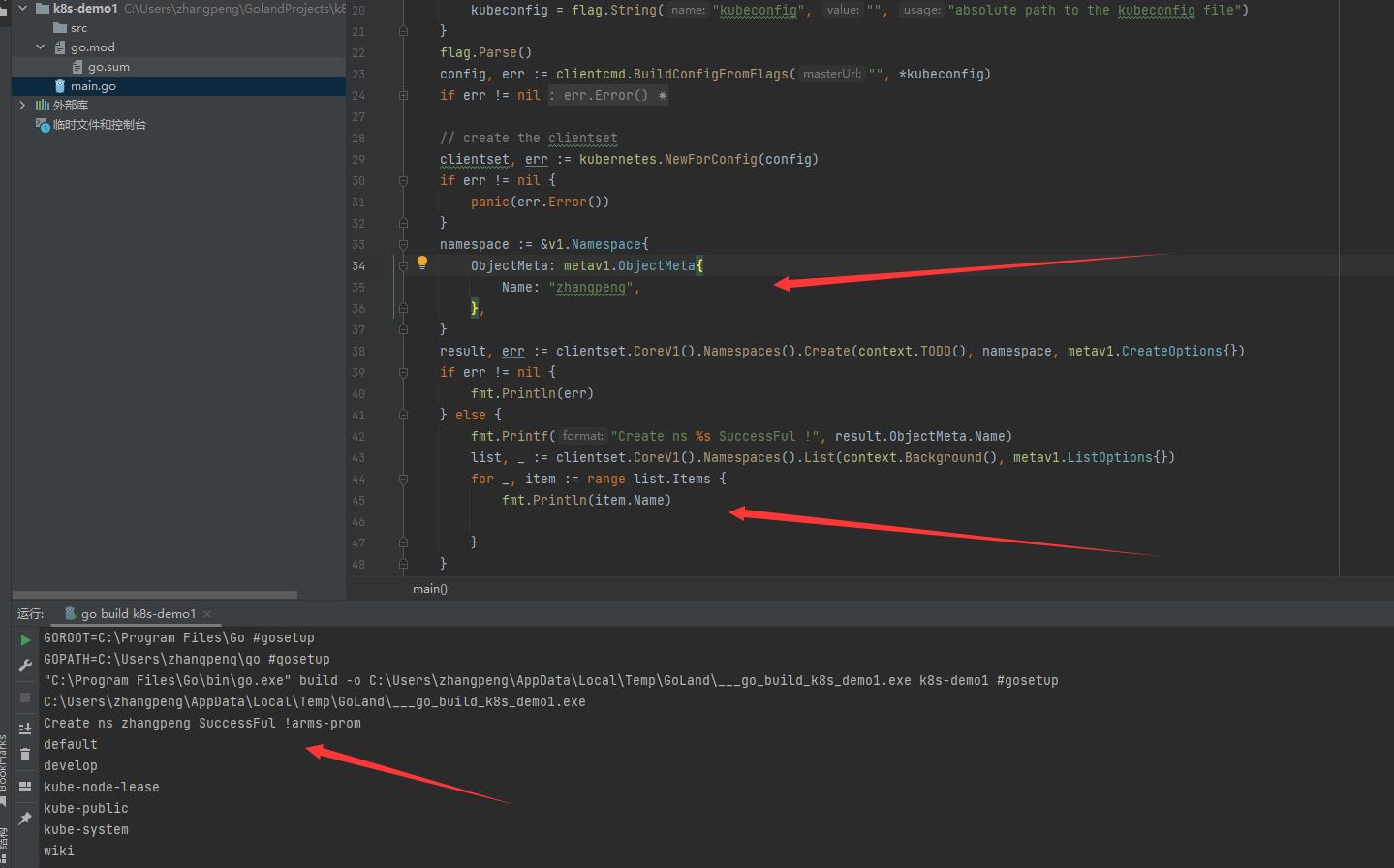
嗯打印在一起了 也可以加个换行符?

创建一个deployment
deployment是属于appv1的apiversion.当然了Goland中corev1().后面可以试一下补全是没有deployment的选项的!

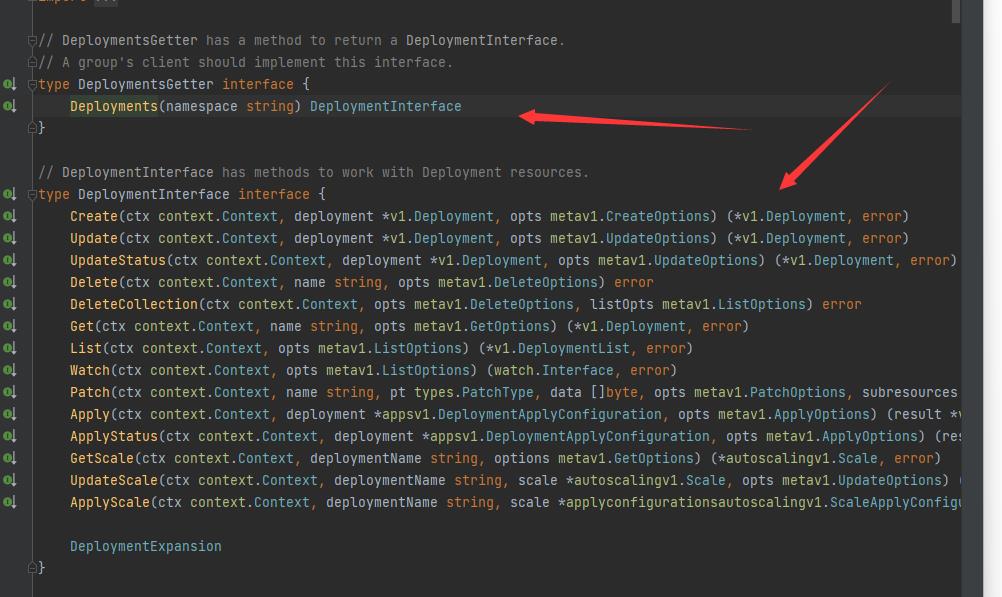
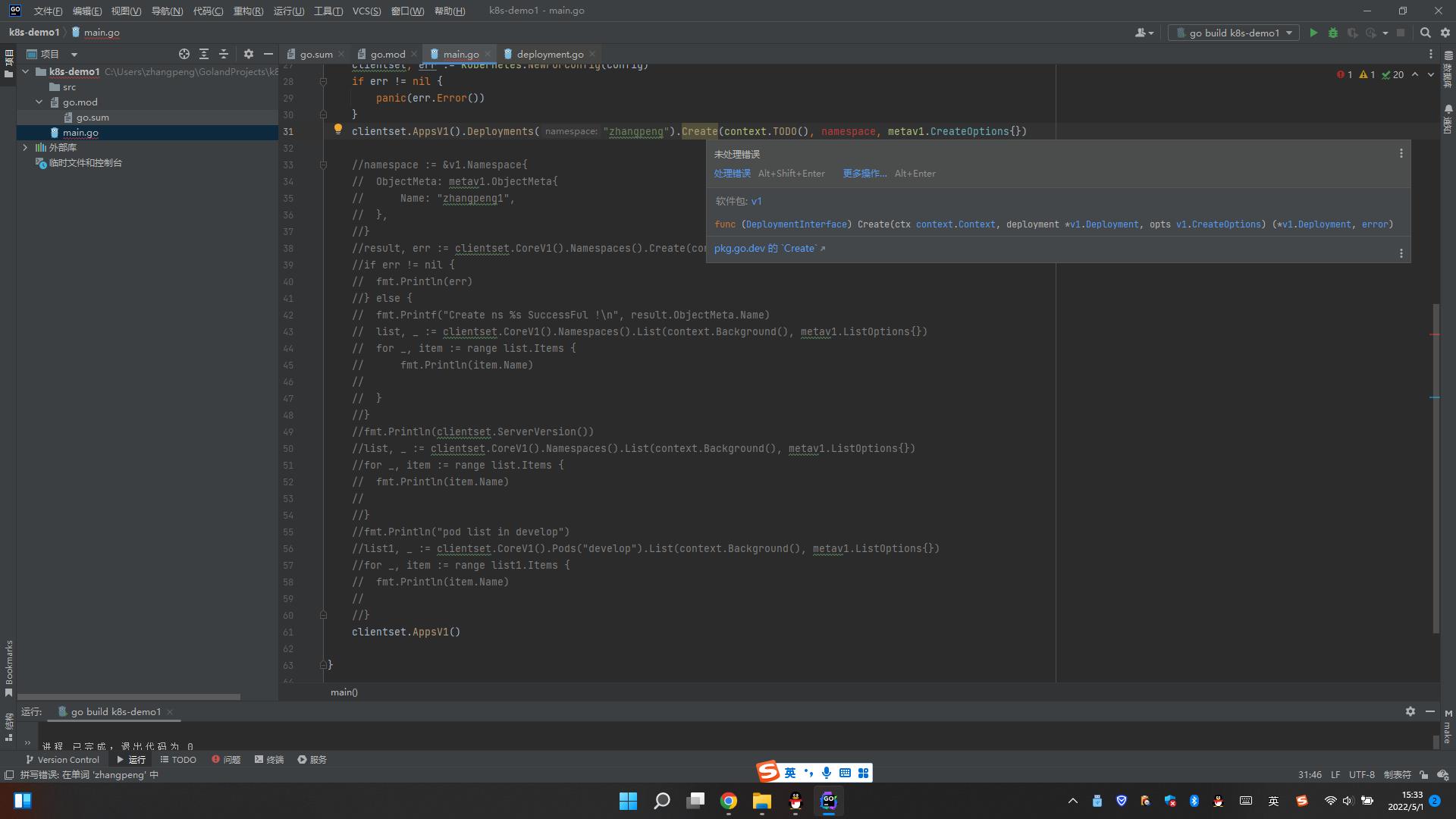
*v1.Deployment怎么处理呢?单独写一个deployment的yaml文件然后文件流读取?或者直接在go文件中定义deployment的配置?
生成yaml读取文件流的方式:
生成yaml文件
kubectl create deployment nginx --image=nginx -o yaml --dry-run=client >nginx.yaml
nginx.yaml
apiVersion: apps/v1
kind: Deployment
metadata:
creationTimestamp: null
labels:
app: nginx
name: nginx
spec:
replicas: 1
selector:
matchLabels:
app: nginx
strategy:
template:
metadata:
creationTimestamp: null
labels:
app: nginx
spec:
containers:
- image: nginx
name: nginx
resources:
status:
将文件保存为src/yamls/nginx.yaml

main.go
package main
import (
"context"
"encoding/json"
"flag"
"fmt"
"io/ioutil"
v1 "k8s.io/api/apps/v1"
metav1 "k8s.io/apimachinery/pkg/apis/meta/v1"
"k8s.io/apimachinery/pkg/util/yaml"
"k8s.io/client-go/kubernetes"
"k8s.io/client-go/tools/clientcmd"
"k8s.io/client-go/util/homedir"
"path/filepath"
)
func main()
var kubeconfig *string
if home := homedir.HomeDir(); home != ""
kubeconfig = flag.String("kubeconfig", filepath.Join(home, ".kube", "config"), "(optional) absolute path to the kubeconfig file")
else
kubeconfig = flag.String("kubeconfig", "", "absolute path to the kubeconfig file")
flag.Parse()
config, err := clientcmd.BuildConfigFromFlags("", *kubeconfig)
if err != nil
panic(err.Error())
// create the clientset
clientset, err := kubernetes.NewForConfig(config)
if err != nil
panic(err.Error())
b, err := ioutil.ReadFile("src/yamls/nginx.yaml")
nginxDep := &v1.Deployment
nginxJson, _ := yaml.ToJSON(b)
if err = json.Unmarshal(nginxJson, nginxDep); err != nil
return
if _, err = clientset.AppsV1().Deployments("zhangpeng").Create(context.Background(), nginxDep, metav1.CreateOptions); err != nil
fmt.Println(err)
return
go run main.go

go run main.go再运行一遍
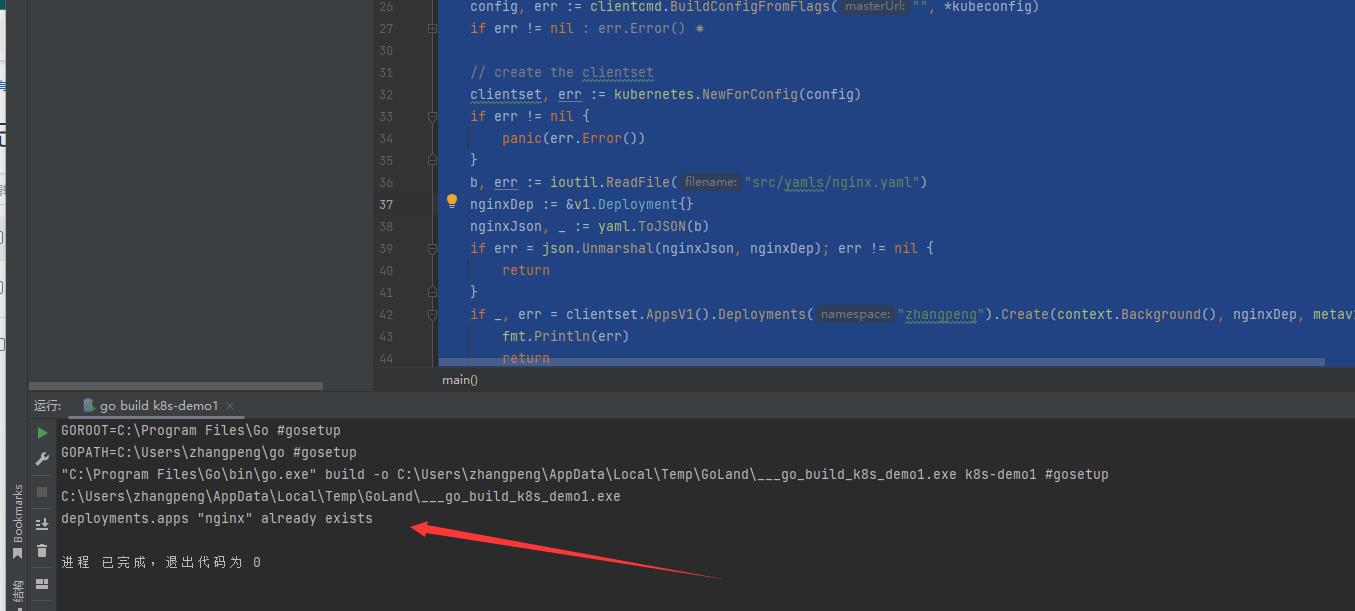
运行第二次就报错已经创建了,基本达到目标,其他的问题以后处理!
go文件中直接定义deployment的配置
package main
import (
"context"
"flag"
"fmt"
v1 "k8s.io/api/apps/v1"
corev1 "k8s.io/api/core/v1"
metav1 "k8s.io/apimachinery/pkg/apis/meta/v1"
"k8s.io/client-go/kubernetes"
"k8s.io/client-go/tools/clientcmd"
"k8s.io/client-go/util/homedir"
"path/filepath"
)
func main()
var kubeconfig *string
if home := homedir.HomeDir(); home != ""
kubeconfig = flag.String("kubeconfig", filepath.Join(home, ".kube", "config"), "(optional) absolute path to the kubeconfig file")
else
kubeconfig = flag.String("kubeconfig", "", "absolute path to the kubeconfig file")
flag.Parse()
config, err := clientcmd.BuildConfigFromFlags("", *kubeconfig)
if err != nil
panic(err.Error())
// create the clientset
clientset, err := kubernetes.NewForConfig(config)
if err != nil
panic(err.Error())
namespace := "default"
var replicas int32 = 1
deployment := &v1.Deployment
ObjectMeta: metav1.ObjectMeta
Name: "nginx",
Labels: map[string]string
"app": "nginx",
"env": "dev",
,
,
Spec: v1.DeploymentSpec
Replicas: &replicas,
Selector: &metav1.LabelSelector
MatchLabels: map[string]string
"app": "nginx",
"env": "dev",
,
,
Template: corev1.PodTemplateSpec
ObjectMeta: metav1.ObjectMeta
Name: "nginx",
Labels: map[string]string
"app": "nginx",
"env": "dev",
,
,
Spec: corev1.PodSpec
Containers: []corev1.Container
Name: "nginx",
Image: "nginx:1.16.1",
Ports: []corev1.ContainerPort
Name: "http",
Protocol: corev1.ProtocolTCP,
ContainerPort: 80,
,
,
,
,
,
,
,
deploymentList, err := clientset.AppsV1().Deployments(namespace).Create(context.TODO(), deployment, metav1.CreateOptions)
fmt.Println(err, deploymentList)
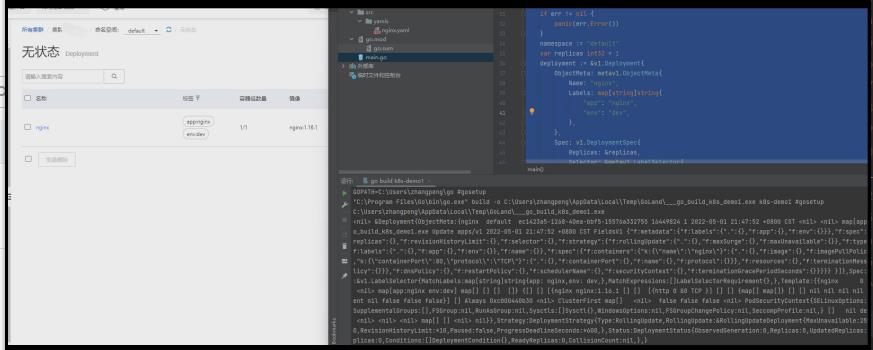
参照:https://blog.csdn.net/xujiamin0022016/article/details/123434916
以上两种方式我还是喜欢单独写yaml的方式…
总结
- create就写这两个有代表性的了namespace and deployment.deployment还是很有代表性的…
- yaml的方式还是很方便,还是喜欢文件流的方式。
- 先简单搞一下crud。增删改查。然后想一下怎么整合一下一步一步来吧
以上是关于client-go连接kubernetes集群-create的主要内容,如果未能解决你的问题,请参考以下文章